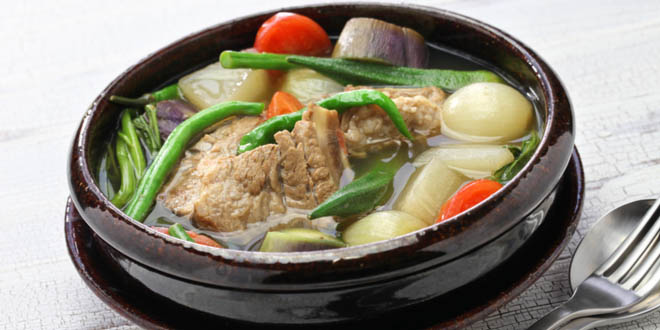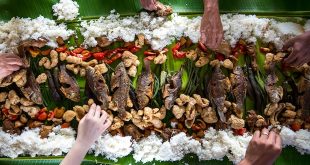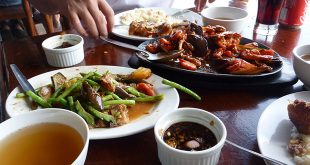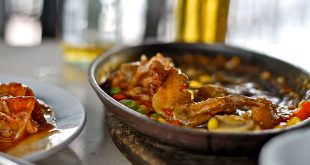Last Updated on March 15, 2023
I’ve been a fan of Anthony Bourdain for several years. Watching his shows has inspired me to write about and pursue my own food adventures. So I was full of pride when he recently visited the Philippines and discussed his belief that Filipino dishes could be the next big food trend in America. Given his expertise as a chef and professional foodie, I agree with him. As a Filipino, I would dare say that our cuisine could capture the hearts and taste buds of the entire world!
If you want to get ahead of the Filipino food craze, here’s a look at some traditional and well-loved dishes. They are a must try when you visit the country or your local Filipino restaurant. Let’s begin with a meal that Anthony Bourdain appropriately describes as: “that’s the one that’s going to hook ‘em.”
Sisig
View this post on Instagram
To properly understand this dish, let’s quickly explore its humble origins. Sisig was created in Angeles City (Pampanga). Locals would buy cheap pig’s head and innards from the commissaries of Clark US Air Base. An innovative canteen owner named Aling Lucing boiled and broiled these wonderful pig parts. She then seasoned it with vinegar and soy sauce. After that, she mixed it with chopped onions, chicken liver. Finally, Aling Lucing served it on a piping hot metal plate. As soon as the chopped up pigs’ head hit the metal plate, it sizzled and popped until the fatty meat reached its desired crispiness. This was the birth of the modern day sisig.
Now, sisig is a staple in most eateries and restaurants. Each order arrives on the sisig’s trademark sizzling hot plate that crackles. Once on the table, you can make your bite of sisig perfect by mixing in extra soy sauce, hot sauce, chili and calamansi juice (a native lime). You can easily devour a few cups of rice or drink a few bottles of ice-cold beer (my personal favorite) with your sisig.
TAKEAWAY: Sisig has become such an outstanding dish, that Angeles City celebrates an annual festival called Sisig Fiesta to showcase the best pig dishes of the Philippines. And, what is more, this year the city has also declared Sisig an “Intangible Cultural Heritage”. In fact, they have prepared some policies to safeguard and honor this delicious meal.
Adobo
No discussion of Filipino cuisine will be complete without mentioning adobo. It’s an icon. But more than just a dish, it is a cooking method. Adobo is used to stew pork, chicken or seafood with garlic, bay leaf and black pepper corns in soy sauce and vinegar. The ingredients and cooking style of adobo may also vary from region to region. So if you are in Bicol (Southern region), you may get to taste adobo cooked with coconut milk, which makes for a richer dish. But whatever version you end up trying, adobo maintains its simple balance of sweetness, sourness, and spice that goes perfectly with rice.
Sinigang
Sinigang is my favorite! It is a savory and sour soup dish that is cooked with beef, pork or shrimp (with pork being the more popular option). The meat is stewed for hours with tomatoes, garlic, onions, and tamarind, which is the source for the sourness in the dish. During the last 30 minutes, a variety of vegetables are added like okra, taro corms, water spinach, long beans, and eggplant. Like most Filipinos, I like adding long green peppers that spice and give an additional depth of flavor to my sinigang.
After giving all these ingredients time to dance with each other in the boiling pot, what is left is a hearty and sour soup. This meal is like a warm hug inside your tummy, especially when eaten during a cold rainy day. If you like Thailand’s Tom Yum soup, you will surely fall for our sinigang. Visit Eat Like Pinoy for the best Pork Sinigang recipe.
Dinuguan
Loosely translated dinuguan means, “to be stewed with blood.” It sounds alarming but dinuguan shares elements with the more familiar blood sausage and black pudding. Pork offal like lungs, kidneys, intestines, ears, heart, and snout, and a little meat are simmered in a rich gravy of pork blood, garlic, chili, and vinegar. After soaking up each other’s flavor, we are left with a balance of savory, sour, spicy, and porky goodness. That is further elevated by a variety of textures due to the mixture of pork offals.
And more than just being a staple of Filipino dinning tables, dinuguan is a reflection of the country’s poor history. Like the sisig, humble and almost throw away parts of the pig were used by crafty and ingenious home cooks. That way, they provide maximum sustenance and flavor for their families. As such, dinuguan is a dish that is close to every Filipino’s heart.
Kare-Kare
Kare-kare is another Filipino dish with a funny sounding name. But when combined with its unique flavor and textures, leads to a very memorable dinning experience. What sets kare-kare apart from other Filipino stews is the thick, savory peanut sauce. This sauce is added to the stewed oxtail, which is usually just the meat used for the dish. However, some variations use both calves and pigs’ feet or beef offal and tripe. And for those on a diet, seafood, as well as all vegetable kare-kare’s, can be an option.
Whatever kind of kare-kare you get to taste, it will go perfectly with a steaming cup of rice. Moreover, if you accompany it by bagoong (shrimp paste), it will round out the richness of the dish with some saltiness.
The Breakfast Trinity (Tapa, Tocino and Longganisa)
Finally, we end with a trio of dishes that usually marks the start of every Filipinos day, which are tapa, tocino and longganisa. For beef lovers, tapa is dried or cured beef that can be salty, sweet or spicy. For pork lovers, tocino is your best bet. It is pork belly or back fat that is cured with sugar. And for those who love sausages in the morning, longganisa will be the perfect fuel to start your day. Each region of the Philippines has their own distinct version of longganisa. In Lucban for example, their longganisa is know for being very garlicky while in Guagua they tend to make theirs very salty and almost sour. These three breakfast dishes are usually combined with garlic rice and a fried egg. This makes a very “happy meal” for Filipinos.
I hope I’ve piqued your interest to try some of these dishes. I think that they define our cuisine. And if you are not “hooked” as Anthony Bourdain says, the Philippines have 7,000 or so islands, each with its own variation on these dishes. One of which will surely capture your heart!
 Travel for Food Hub The Food Blog for Travel Lovers
Travel for Food Hub The Food Blog for Travel Lovers












